lock Oldsmobile Aurora 1998 s Owner's Guide
[x] Cancel search | Manufacturer: OLDSMOBILE, Model Year: 1998, Model line: Aurora, Model: Oldsmobile Aurora 1998Pages: 380, PDF Size: 19.75 MB
Page 79 of 380
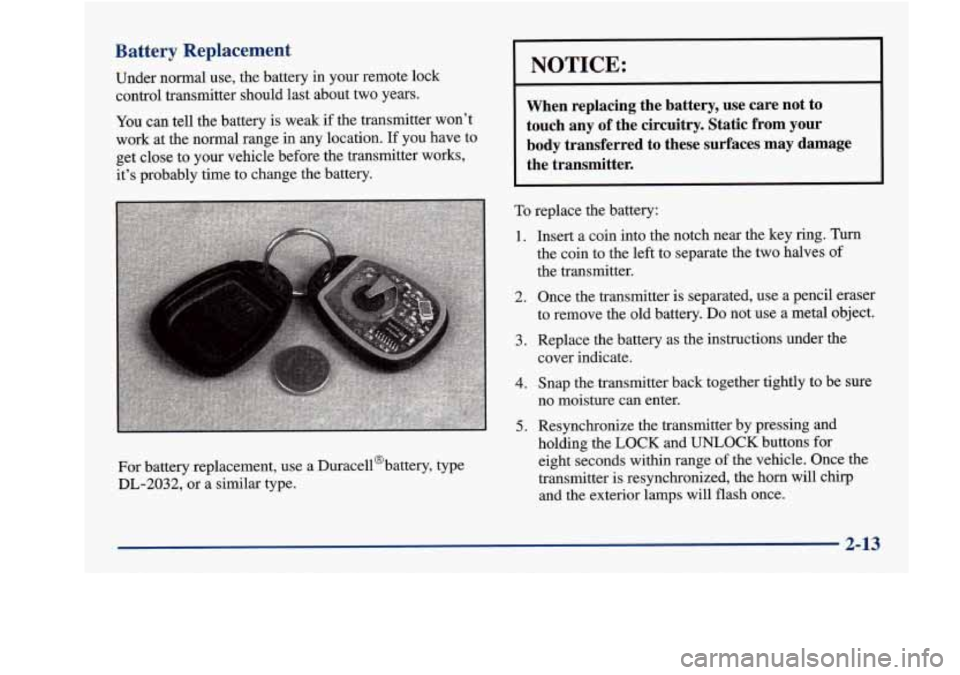
Battery Replacement
Under normal use, the battery in your remote lock
control transmitter should last about two years.
You can tell the battery is weak if the transmitter won’t
work at the normal range in any location.
If you have to
get close to your vehicle before the transmitter works,
it’s probably time to change the battery.
For battery replacement, use a Duracell@battery, type
DL-2032,
or a similar type.
1.
2.
3.
4.
5.
NOTICE:
When replacing the battery, use care not to touch any of the circuitry. Static from your
body transferred to these surfaces
may damage
the transmitter.
To replace the battery:
Insert a coin into the notch near the key ring. Turn
the coin to the left to separate the two halves of
the transmitter.
Once the transmitter is separated, use a pencil eraser
to remove the old battery. Do not use a metal object.
Replace the battery as the instructions under the
cover indicate.
Snap the transmitter back together tightly to be sure
no moisture can enter.
Resynchronize the transmitter by pressing and
holding the
LOCK and UNLOCK buttons for
eight seconds within range of the vehicle. Once the
transmitter is resynchronized, the horn will cllrp
and the exterior lamps will flash once.
c 2-13
Page 80 of 380
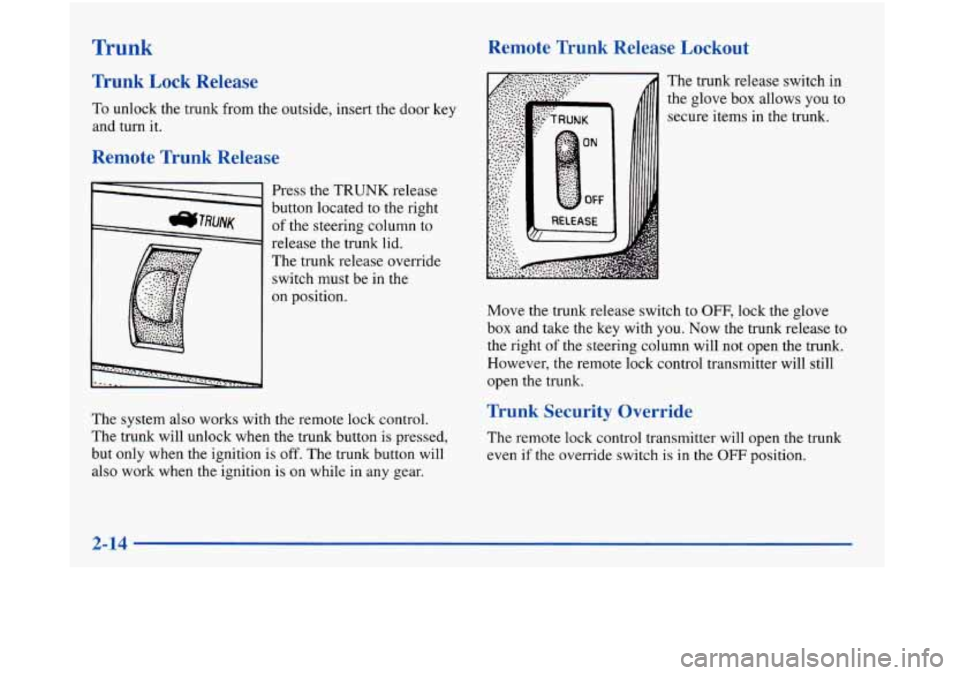
Trunk
Trunk Lock Release
To unlock the trunk from the outside, insert the door key
and turn it.
Remote Trunk Release
Press the TRUNK release
button located
to the right
of the steering column to
release the trunk lid.
The trunk release override
switch must be in the
on position.
The system also works with the remote lock control.
The trunk will unlock when the trunk button is pressed,
but only when the ignition is off. The trunk button will
also work when the ignition
is on while in any gear.
Remote Trunk Release Lockout
The trunk release switch in
the glove
box allows you to
secure items in the trunk.
Move the trunk release switch to
OFF, lock the glove
box and take the key with you. Now the trunk release to
the right of the steering column will not open the trunk.
However, the remote lock control transmitter will still
open the trunk.
Trunk Security Override
The remote lock control transmitter will open the trunk
even
if the override switch is in the OFF position.
2-14
Page 81 of 380
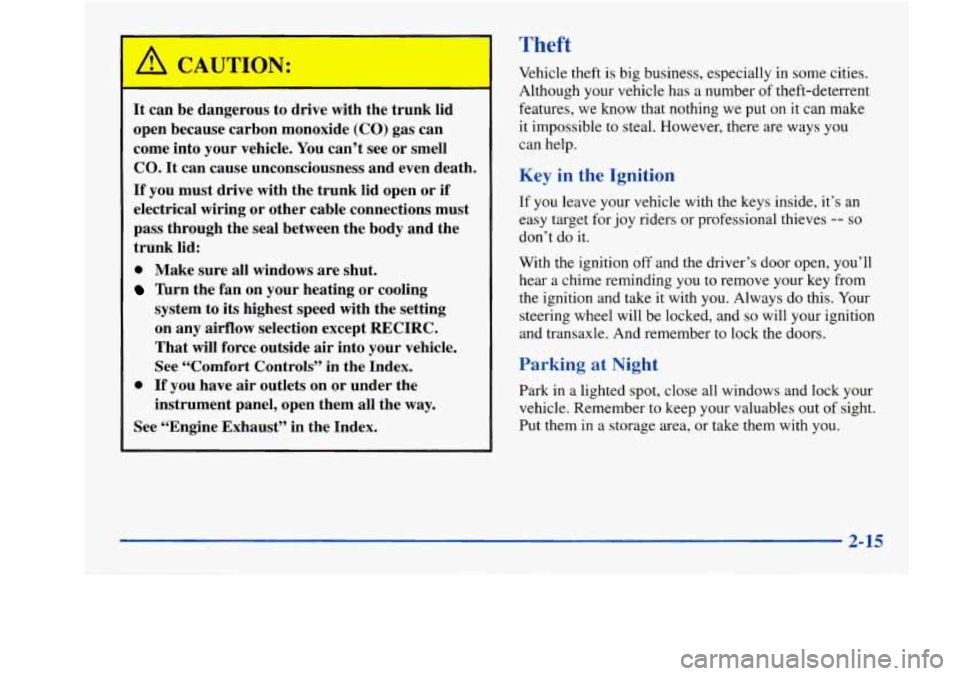
A CAUTION:
It can be dangerous to drive with the trunk lid
open because carbon monoxide
(CO) gas can
come into your vehicle. You can’t see
or smell
CO. It can cause unconsciousness and even death.
If you must drive with the trunk lid open or if
electrical wiring or other cable connections must
pass through the seal between the body and the
trunk lid:
0 Make sure all windows are shut.
Turn the fan on your heating or cooling
system to its highest speed with the setting
on
any airflow selection except RECIRC.
That will force outside air into your vehicle.
See “Comfort Controls” in the Index.
instrument panel, open them all the
way.
0 If you have air outlets on or under the
See “Engine Exhaust” in the Index.
Theft
Vehicle theft is big business, especially in some cities.
Although your vehicle has a number of theft-deterrent
features, we know that nothing we put on it
can make
it impossible
to steal. However, there are ways you
can help.
Key in the Ignition
If you leave your vehicle with the keys inside, it’s an
easy target for joy riders or professional thieves
-- so
don’t do it.
With the ignition off and the driver’s door open, you’ll
hear a chime reminding you to remove your key from
the ignition and take
it with you. Always do this. Your
steering wheel will be locked, and
so will your ignition
and transaxle. And remember to lock the doors.
Parking at Night
Park in a lighted spot, close all windows and lock your
vehicle. Remember to keep your valuables out
of sight.
Put them in a storage area, or take them with you.
2-15
Page 82 of 380
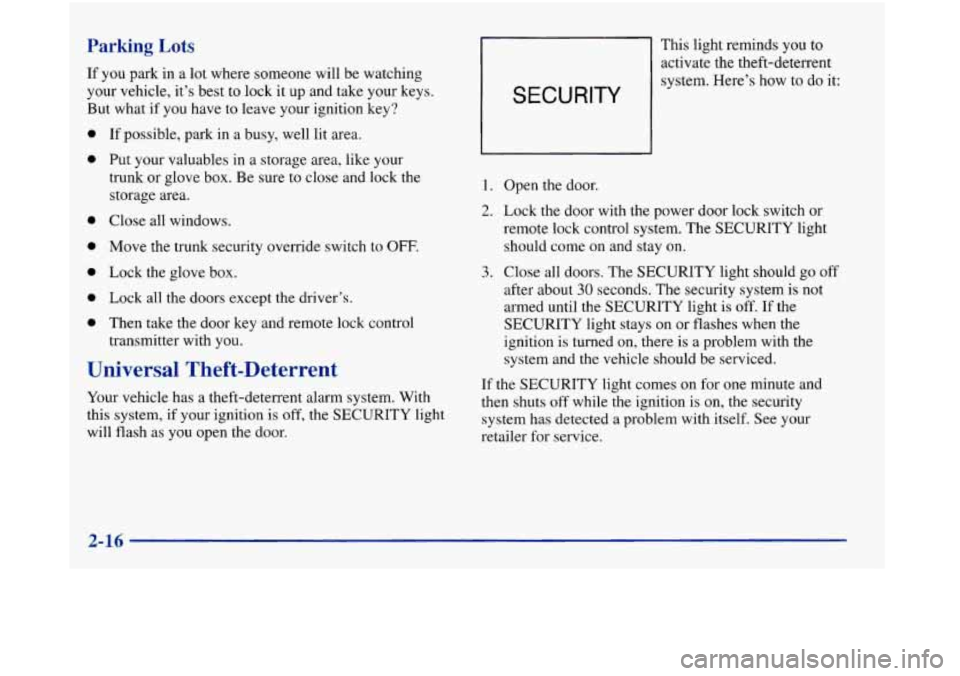
Parking Lots
If you park in a lot where someone will be watching
your vehicle,
it’s best to lock it up and take your keys.
But what
if you have to leave your ignition key?
If possible, park in a busy, well lit area.
Put your valuables in a storage area, like your
trunk or glove
box. Be sure to close and lock the
storage area.
Close all windows.
Move the trunk security override switch to
OFF.
Lock the glove box.
Lock all the doors except the driver’s.
Then take the door key and remote lock control
transmitter with you.
Universal Theft-Deterrent
Your vehicle has a theft-deterrent alarm system. With
this system,
if your ignition is off, the SECURITY light
will flash as you open the door. This
light reminds you
to
activate the theft-deterrent
SECURITY
system. Here’s how to do it:
1. Open the door.
2. Lock the door with the power door lock switch or
remote lock control system. The SECURITY light
should come on and stay on.
3. Close all doors. The SECURITY light should go off
after about
30 seconds. The security system is not
armed until the SECURITY light
is off. If the
SECURITY light stays on or flashes when the
ignition is turned on, there
is a problem with the
system and
the vehicle should be serviced.
If the SECURITY light comes
on for one minute and
then shuts off while the ignition is on, the security
system has detected a problem with itself. See your
retailer for service.
2-16
Page 83 of 380
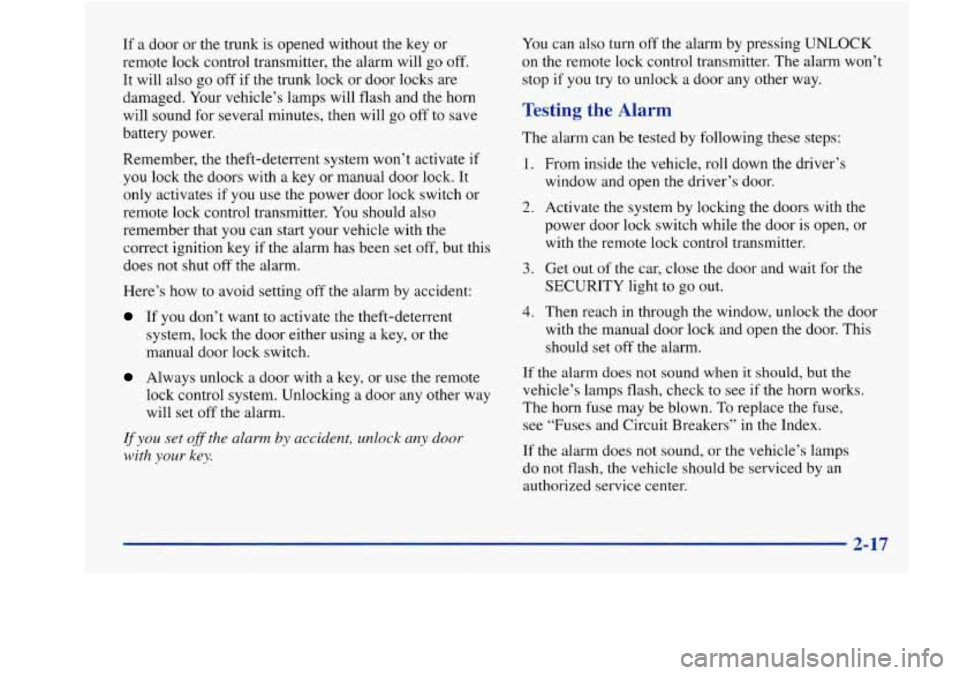
If a door or the trunk is opened without the key or
remote lock control transmitter, the alarm will go
off.
It will also go off if the trunk lock or door locks are
damaged. Your vehicle’s lamps will flash and the horn
will sound for several minutes, then will go off to save
battery power.
Remember, the theft-deterrent system won’t activate if
you lock the doors with a key or manual door lock. It
only activates if you use the power door lock switch or
remote lock control transmitter. You should also
remember that you can start your vehicle with the
correct ignition key
if the alarm has been set off, but this
does not shut
off the alarm.
Here’s how to avoid setting off the alarm by accident:
If you don’t want to activate the theft-deterrent
system, lock the door either using a key, or the
manual door lock switch.
Always unlock a door with a key, or use the remote
lock control system. Unlocking a door any other way
will set off the alarm.
If you set off the alarm by accident, unlock any door
with
your key.
You can also turn off the alarm by pressing UNLOCK
on the remote lock control transmitter. The alarm won’t
stop if you
try to unlock a door any other way.
Testing the Alarm
The alarm can be tested by following these steps:
1. From inside the vehicle, roll down the driver’s
window and open the driver’s door.
2. Activate the system by locking the doors with the
power door lock switch while the door is open, or
with the remote lock control transmitter.
3. Get out of the car, close the door and wait for the
SE.CURITY light to go out.
4. Then reach in through the window, unlock the door
with the manual door lock and open the door. This
should set off the alarm.
If the alarm does not sound when it should, but the
vehicle’s lamps flash, check to see if the horn works.
The horn fuse may be blown.
To replace the fuse,
see “Fuses and Circuit Breakers’’ in the Index.
If the alarm does not sound, or the vehicle’s lamps
do not flash, the vehicle should be serviced by an
authorized service center.
2-17
Page 84 of 380
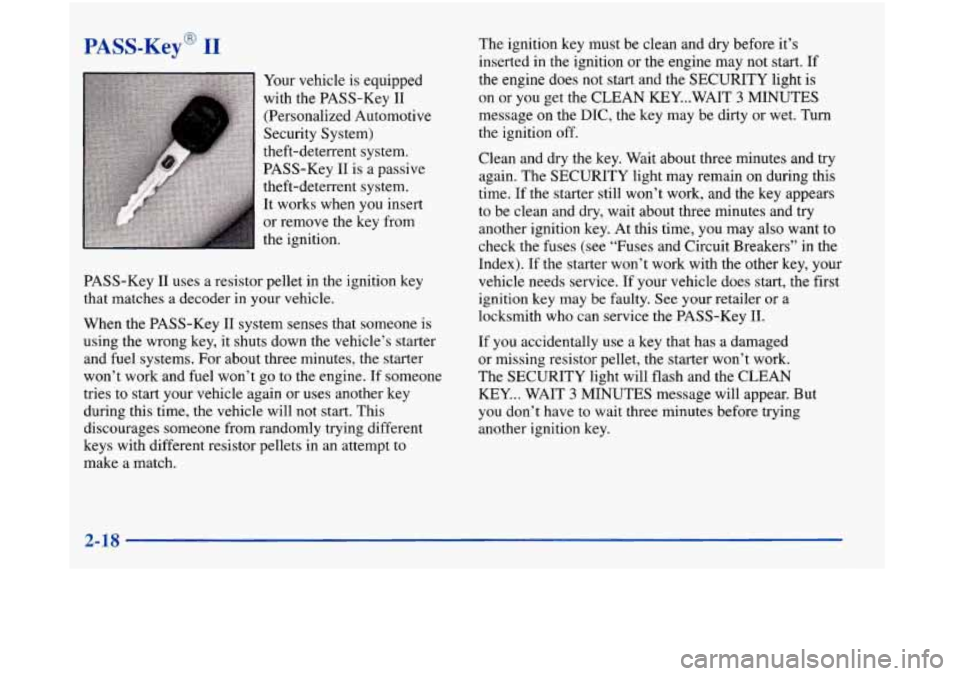
PASS-Key@ I1
Your vehicle is equipped
with the PASS-Key I1
(Personalized Automotive
Security System)
theft-deterrent system.
PASS-Key I1 is a passive
theft-deterrent system.
It works when you insert
or remove the key from
the ignition.
PASS-Key
I1 uses a resistor pellet in the ignition key
that matches a decoder in your vehicle.
When the PASS-Key
I1 system senses that someone is
using the wrong key, it shuts down the vehicle’s starter
and fuel systems. For about three minutes, the starter
won’t work and fuel won’t go to the e,ngine. If someone
tries to start your vehicle again or uses another key
during this time, the vehicle will not start. This
discourages someone from randomly trying different
keys with different resistor pellets in an attempt to
make a match. The ignition key must be clean and dry before
it’s
inserted in the ignition or the engine may not start. If
the engine does not start and the SECURITY light
is
on or you get the CLEAN KEY...WAIT 3 MINUTES
message on the DIC, the key may be dirty or wet.
Turn
the ignition off.
Clean and dry the key. Wait about three minutes and try
again. The SECURITY light may remain on during this
time. If
the starter still won’t work, and the key appears
to be clean and dry, wait about three minutes and try
another ignition key. At this time, you may also want to
check the fuses (see “Fuses and Circuit Breakers” in the
Index). If the starter won’t work with the other key, your
vehicle needs service. If your vehicle does start, the first
ignition key may be faulty. See your retailer
or a
locksmith who can service the PASS-Key
11.
If you accidentally use a key that has a damaged
or missing resistor pellet, the starter won’t work.
The SECURITY light will flash and the CLEAN
KEY... WAIT 3 MINUTES message will appear. But
you don’t have
to wait three minutes before trying
another ignition key.
2-18
Page 85 of 380
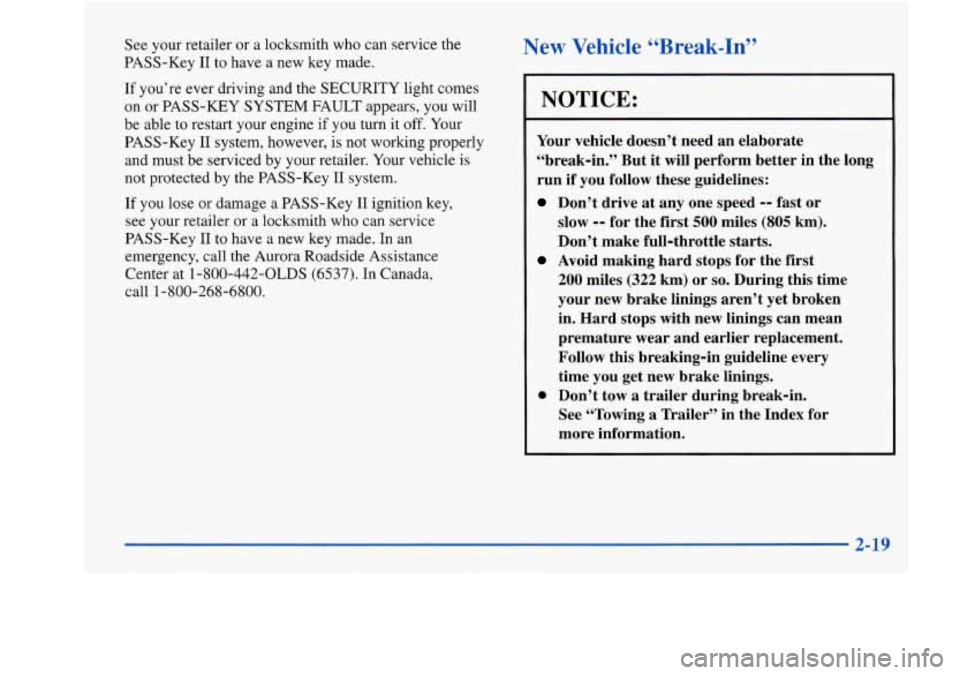
See your retailer or a locksmith who can service the
PASS-Key I1 to have a new key made.
If you’re ever driving and the SECURITY light comes
on or PASS-KEY SYSTEM
FAULT appears, you will
be able
to restart your engine if you turn it off. Your
PASS-Key
I1 system, however, is not working properly
and must be serviced
by your retailer. Your vehicle is
not protected by the PASS-Key I1 system.
If you lose
or damage a PASS-Key I1 ignition key,
see your retailer
or a locksmith who can service
PASS-Key
I1 to have a new key made. In an
emergency, call the Aurora Roadside Assistance
Center at
1-800-442-OLDS (6537). In Canada,
call
1-800-268-6800.
New Vehicle 44Break-In”
NOTICE:
Your vehicle doesn’t need an elaborate
“break-in.” But it will perform better in the long
run if you follow these guidelines:
Don’t drive at any one speed -- fast or
slow
-- for the first 500 miles (805 km).
Don’t make full-throttle starts.
200 miles (322 km) or so. During this time
your new brake linings aren’t yet broken
in. Hard stops with new linings can mean
premature wear and earlier replacement.
Follow this breaking-in guideline every
time you get new brake linings.
Don’t tow
a trailer during break-in.
See “Towing
a Trailer” in the Index for
more information.
Avoid making hard stops for the first
2-19
Page 86 of 380
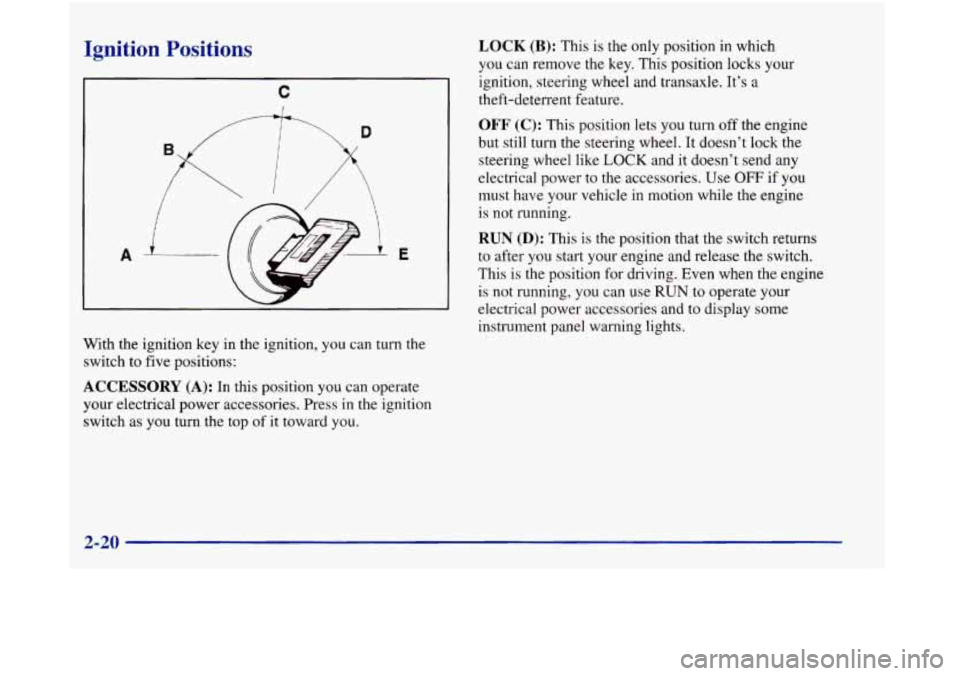
Ignition Positions
C
I
A E
With the ignition key in the ignition, you can turn the
switch to five positions:
ACCESSORY (A): In this position you can operate
your electrical power accessories. Press in the ignition
switch as you turn the top
of it toward you.
LOCK (B): This is the only position in which
you can remove the
key. This position locks your
ignition, steering wheel and transaxle. It’s a
theft-deterrent feature.
OFF (C): This position lets you turn off the engine
but still turn the steering wheel. It doesn’t lock the steering wheel like
LOCK and it doesn’t send any
electrical power
to the accessories. Use OFF if you
must have your vehicle in motion while the engine
is not running.
RUN (D): This is the position that the switch returns
to after you start your engine and release the switch.
This
is the position for driving. Even when the engine
is not running, you can
use RUN to operate your
electrical power accessories and to display some
instrument panel warning lights.
Page 87 of 380
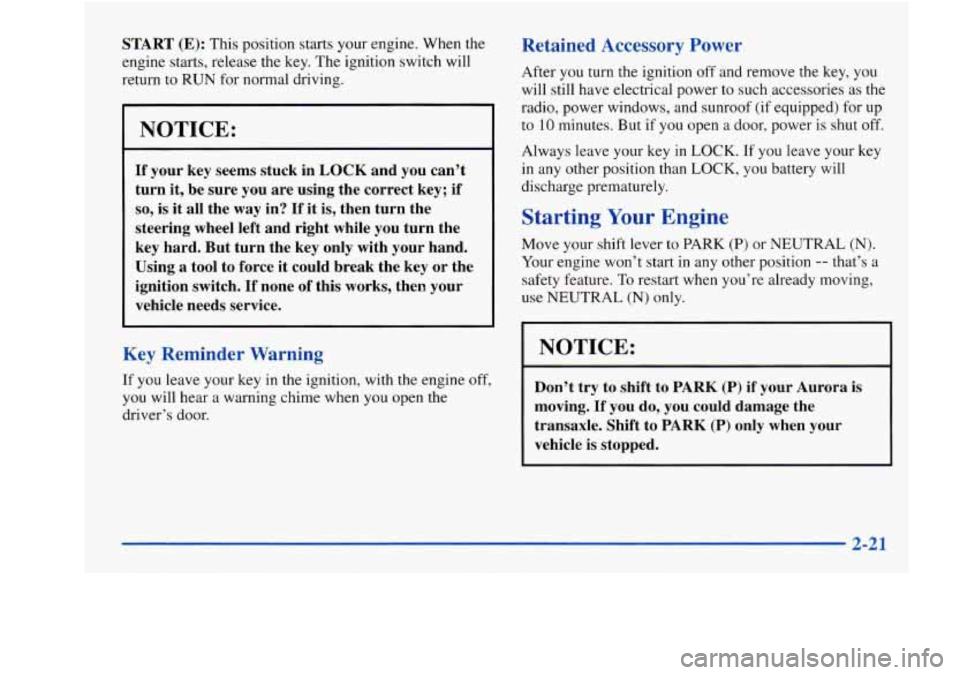
START (E): This position starts your engine. When the
engine starts, release the key. The ignition switch will
return to
RUN for normal driving.
FNOTICE:
If your key seems stuck in LOCK and you can’t
turn
it, be sure you are using the correct key; if
so, is it all the way in? If it is, then turn the
steering wheel left and right while you turn the
key hard. But turn the key only with your hand.
Using
a tool to force it could break the key or the
ignition switch.
If none of this works, then your
vehicle needs service.
Key Reminder Warning
If you leave your key in the ignition, with the engine off,
you will hear a warning chime when you open the
driver’s door.
Retained Accessory Power
After you turn the ignition off and remove the key, you
will still have electrical power to such accessories
as the
radio, power windows, and sunroof (if equipped) for up
to
10 minutes. But if you open a door, power is shut off.
Always leave your key in
LOCK. If you leave your key
in any other position than
LOCK, you battery will
discharge prematurely.
Starting Your Engine
Move your shift lever to PARK (P) or NEUTRAL (N).
Your engine won’t start in any other position -- that’s a
safety feature.
To restart when you’re already moving,
use NEUTRAL
(N) only.
NOTICE:
~ ~ ~~
Don’t try to shift to PARK (P) if your Aurora is I
moving. If you do, you could damage the
transaxle. Shift to PARK
(P) only when your
vehicle is stopped.
Page 90 of 380
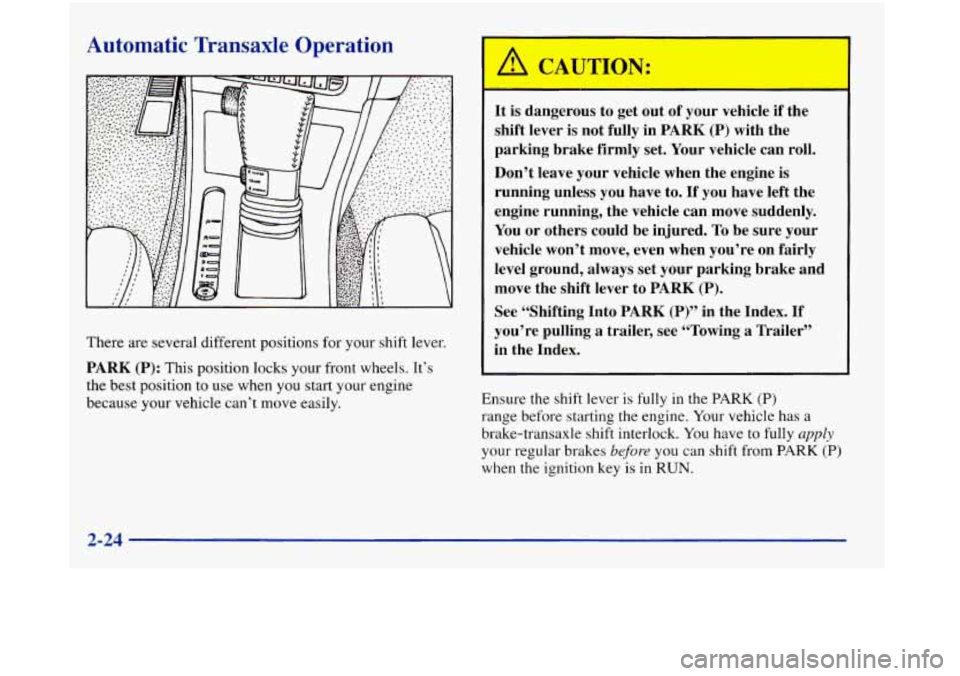
Automatic Transaxle Operation
There are several different positions for your shift lever.
PARK (P): This position locks your front wheels. It’s
the best position
to use when you start your engine
because your vehicle can’t move easily. It
is dangerous to get
out of your vehicle if the
shift lever is not fully in
PARK (P) with the
parking brake firmly set. Your vehicle can roll.
Don’t leave your vehicle when the engine is
running unless you have
to. If you have left the
engine running, the vehicle can move suddenly.
You
or others could be injured. To be sure your
vehicle won’t move, even when you’re on fairly
level ground,
always set your parking brake and
move the shift lever to
PARK (P).
See “Shifting Into PARK (P)” in the Index. If
you’re pulling a trailer, see “Towing a Trailer’’
in the Index.
Ensure the shift lever
is fully in the PARK (P)
range before starting the engine. Your vehicle has a
brake-transaxle shift interlock. You have to fully
apply
your regular brakes bcfore you can shift from PARK (P)
when the ignition key is in RUN.
2-24